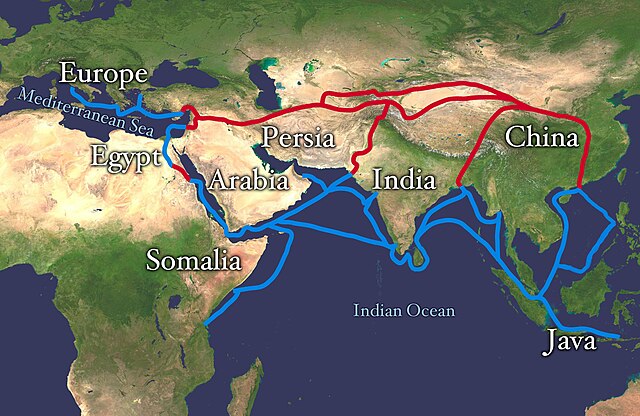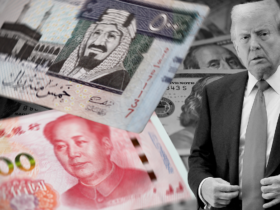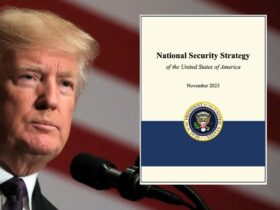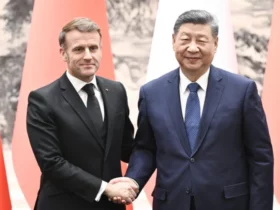During the year 138 (2nd century BC), Emperor Wudi of the Han Dynasty sent Zhang Qian on a diplomatic mission to observe the western parts of the empire and Central Asia. He was the first representative to provide reliable information about those territories to the Chinese imperial court, located in Chang’an. In the year 119 BC, Zhang made a new trip, this time taking, in addition to 300 companions, thousands of cattle and sheep, as well as enormous quantities of silk and other gifts that inaugurated a practice of exchange of diplomatic envoys, trips, trade between the Chinese rulers and those of Central Asia.
This led the emperors of the Han Dynasty to build roads, lodges and posts along this route, in order to offer food, accommodation and safety to travelers and merchants. This was the origin of the Silk Road, which connected east and west, and China with Central Asia and Europe. It departed from the imperial capital, crossed the current northwestern Chinese province of Gansu and the Uyghur autonomous region of Xinjiang, as well as the central and western part of Asia, arriving in the Mediterranean.
In this sense, the Silk Road is considered a heritage of humanity. Its creation, existence and operation for so many centuries in antiquity is a testimony that human beings can live in harmony even belonging to different civilizations and that war can be avoided in favor of peace. Various relics found along its route show how Arab and European civilizations lived in harmony with Chinese culture, while protecting their own characteristics, without losing their heritage due to established communication. It also demonstrates that the economies of the peoples were able to complement each other beneficially for all through exchange and trade.
2100 years later, the Chinese government undertook, from a new modality, the idea of reformulating this project. The announcement about China’s intention to reopen the Silk Road was first made by President Xi Jinping during a visit to Kazakhstan, where he gave a lecture at Nazarbayev University in Astana on September 7, 2013. This week, the tenth anniversary of that event is commemorated.
It is about recovering values from the past and transforming them into a code of conduct for modern international relations. The Silk Road land route would have one of its most important nerve points in Urumqi, capital of the Xinjiang Uyghur autonomous region, in northwest China, becoming the transport, finance and logistics center of the Silk Road, continuing into Central Asia and Europe. For 20 years, the countries of Central Asia have revitalized their relations, which has allowed them to foster high levels of cooperation and friendship. From a different perspective than that which prevailed when several of these countries belonged to the Soviet Union, ties have been promoted within a framework of respect and non-interference in internal affairs, including Russia in this perspective. Its membership of the Shanghai Cooperation Organization (SCO) has strengthened mutual trust among its members.
This context made it possible to think about the creation of an innovative approach to integration that would lead to the joint construction of the “Silk Road Economic Belt”, a great work that aims to generate well-being for the people who live along its route. Its construction process has been envisioned as the development of specific areas that will gradually become interconnected over time.
Among the statements of President Xi Jinping regarding the objectives proposed by this project, we can highlight the possibility of having strategic communication and high levels of economic development between the parties; create conditions for a road connection that facilitates transport from the Pacific to the Baltic by expanding intra-border transport infrastructure linking the different regions of Asia; make trade more evident, exploiting the magnitude and potential of markets that serve nearly 3 billion inhabitants and 50 million square kilometers along their route; strengthen monetary circulation to carry out commercial transactions in local currency, in order to reduce circulation costs, increase the capacity to avoid financial risks, increase the competitiveness of the region on the international stage and reinforce communication between peoples, strengthening ties of friendship, intensifying exchanges and solidifying social support for regional cooperation.
On the other hand, China has made in recent years special efforts to strengthen its relations with ASEAN countries, with which a strategic partnership was established since 2003, making clear Beijing’s interest in building links of trust and goodwill with these countries in the neighborhood, especially due to the still pending conflicts regarding maritime delimitation that China intends to resolve at the negotiating table. Within the framework of the search to expand spaces for collaboration, China has considered it necessary to expand its opening to ASEAN countries. In addition, it raised the level of the China-ASEAN free trade zone and supported infrastructure development in the region through the actions of the Asian Infrastructure Investment Bank (AIIB). Likewise, it was proposed to build a maritime component of the Silk Road Economic Belt, imitating the trade that has been done through that route in Southeast Asia since ancient times.
The current sea route would follow the itinerary used in ancient times that connected the ports of southern China to Southeast Asia, India, Arabia and Africa to trade silk, porcelain, tea and spices from Guangzhou to the countries of the Persian Gulf, the same route travelled by Admiral Zheng He in the 15th century. Now, China proposed to rebuild this route in a new maritime Silk Road for the 21st century. The port of Kuantan, on the eastern coast of peninsular Malaysia, would be one of the strategic points, as it is the economic center of the east coast of that country and the most modern city on its coastline.
It must be said that the response of the United States was immediate, projecting the “Indo-Pacific Economic Corridor (IPEC)” in 2013 with similar objectives and in clear competition with China, which poses a new scenario of confrontation.
The American reply shows the importance that this country attaches to the Chinese initiative, which is the expression of an integration mechanism that will serve to promote a civilization based on an ecological philosophy to achieve sustainable development. Both routes (land and sea), also called “one belt, one road” include almost 100 countries, will cost around one trillion dollars, financed basically by the AIIB, and will be implemented over three or four decades. In the same way, the Silk Road Economic Investment Fund, sponsored by Beijing with a fund of 50,000 million dollars, has been acting as a financier.
From a European perspective, Germany seemed to show the greatest interest in the route project, however the war in Ukraine paralyzed many of the projects. The international railway line between Chongqing-Xinjiang in China and Duisburg, the main river port and largest steel center in Europe, located in the large industrial area where the Ruhr and Rhine rivers meet in the Germanic country, could be considered a preview of the new route. Before the conflict, Germany also looked to the east in an area that makes up its “eastern natural geographic hinterland”, among which Russia is especially found.
Regarding Europe, it must be added that the project presented two fundamental land corridors. On the one hand, the northern railway network, the most extensive in the world, which starts from China and passed through Kazakhstan, Russia, Belarus, Poland and Germany, from where it would be distributed to other points throughout Europe; and on the other, the south, which crosses Central Asia and enters Iran to head towards Europe, passing through Turkey. The war has radically changed this perspective.
To begin to operationalize this project, on May 14 and 15, 2017, a forum was held in Beijing with the participation of governments from 29 countries in addition to China and the presence of delegations from more than a hundred interested nations and international entities. The event showed that since the launch of the project by President Xi in 2013, China had already invested more than 50 billion dollars in the Belt and Road countries; 56 commercial economic cooperation zones were created, which had generated 1.1 billion dollars in tax revenue and created 180 thousand jobs, while trade between China and countries along the Belt and Road totaled 913 billion dollars in 2016.
This project has made it possible to reduce poverty, a specific issue in which China proposed 100 investment projects. In the maritime area, China signed cooperation agreements with Thailand, Malaysia, Cambodia, India, Pakistan, Maldives and South Africa, carrying out a strategic connection with many of the countries along the Route, thus establishing a broad cooperative partnership around of the ocean. At this event, Chinese Foreign Minister Wang Yi said that this project has become the most important public good that China has contributed to the world, without this allowing it to consider it a philanthropic work, but rather it is being done based on the idea of win-win.
On a global level, the Chinese project is presented as a new attempt to fill the void left by the United States by abandoning the trans-Pacific association agreement and the transatlantic agreement rejected by Europe and after Brexit was approved in Great Britain, which in its entirety tended towards an isolation of China in a context in which the United States still has great control of the maritime routes through which most of the goods on the globe transit after agreements signed at the end of the Second World War in the China Sea. , Southeast Asia, the Strait of Hormuz and the Red Sea.
The Route project would be a response to China’s need to overcome its deficit in raw materials and energy to meet its development plans: To this end, Russia has become a great ally after Western attempts to block it and sanction it, being able to complement it in the military, economic, energy, financial and transportation fields. Another look shows China in a constant process of development that allows it to begin a projection abroad from a different dimension: stimulating the growth of its less developed areas and seeking markets to place its surplus products.
One of the prioritized countries is Pakistan, where China is expanding and modernizing the port of Gwadar, which would function as “its main port” for trade with Xinjiang and the west of the country in general, tens of thousands of kilometers away from the maritime terminals of eastern China, also avoiding the passage of these goods through the Strait of Malacca, the nerve center of maritime trade in Asia and where China has no control capacity.
In addition, the project contemplates expanding the Karakoram Highway that connects both countries. In this sense, the ASEAN countries have highly valued this project due to the great benefits it is bringing to the 10 members of this association, especially in the field of infrastructure, especially to comply with the ASEAN Connectivity Master Plan that It is in need of an enormous amount of capital, which the United Nations Conference for Trade and Development (UNCTAD) has estimated between 60 thousand and 146 thousand million dollars a year until 2025.
With this initiative, China is linked to the ASEAN master plan and reiterates its willingness to play an active role in the construction and updating of physical infrastructure in the subregion, which will result in an engine of development and prosperity, as various officials, academics and specialists pointed out at an event on the subject held in Phnom Penh, the capital of Cambodia, during the month of November 2017.
If the projects carried out in Kazakhstan, Kyrgyzstan, Tajikistan, Pakistan and Cambodia are added to the arrival of the Silk Road to Russia and Mongolia and the joint declaration of the presidents of China and Russia aimed at promoting infrastructure projects in countries of the Eurasian Economic Union, it can be affirmed that it has started a dynamic that is going to change an important part of the world, since China’s connection with Central, South and Western Asia, and with Europe, will create a brand-new mechanism to face to the future, bringing two continents and very large urban areas closer together, which play an important role in China and will soon do so in other parts of the planet.
Ten years after its creation, the Belt and Road initiative shows figures that account for its success. According to Zheng Shanjie, head of the China National Development and Reform Commission, the country has signed more than 200 cooperation documents with 152 countries and 32 international organizations, covering 83% of the countries with which China has established diplomatic relations. The China-Europe Express Railway has reached 211 cities in 25 European countries, and the New International Land-Sea Trade Corridor has connected the central and western regions of China with more than 300 ports in more than 100 countries.
The official noted that “from 2013 to 2022, the import and export of goods between China and the countries along the Belt and Road increased an average of 8.6% annually,” adding that “its accumulated investment in both senses has exceeded 270,000 million dollars.” This allowed us to create 421,000 local jobs over the past decade, estimating that by 2030, the joint construction of the Belt and Road will have helped lift 7.6 million people out of extreme poverty and 32 million people out of moderate poverty in relevant countries.
Victoria Kwakwa, Vice President of the World Bank for the East Asia and Pacific region, says: “With the Belt and Road Initiative, China has introduced a new form of multilateral cooperation to the world. “This promising initiative aims to deepen economic integration by improving trade, infrastructure, investment and connectivity between people, not only across borders, but also on a transcontinental scale.”

















Leave a Reply